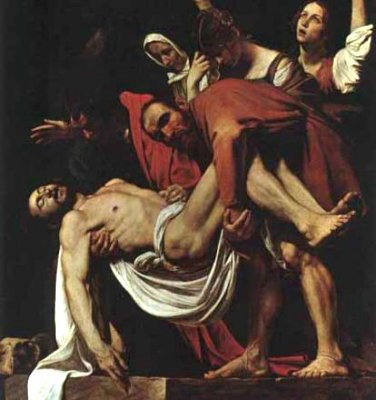Matthew 27:45-66
Lesson 61
Lesson 61
Read both the "King James Bible" and the "New Living Translation."
In this lesson:
First, King Herod tried to kill the infant Jesus (Matthew 2:13). Then, an angry mob wanted to throw Him off a cliff (Luke 4:16-30). Later, the high priest conspired to murder Him (Mark 14:1; John 5:18) and twice Jesus was almost stoned to death (John 8:59; 10:31).
They all failed to stop Jesus.
But in this passage, the Messiah is killed.
First, King Herod tried to kill the infant Jesus (Matthew 2:13). Then, an angry mob wanted to throw Him off a cliff (Luke 4:16-30). Later, the high priest conspired to murder Him (Mark 14:1; John 5:18) and twice Jesus was almost stoned to death (John 8:59; 10:31).
They all failed to stop Jesus.
But in this passage, the Messiah is killed.
Study Tip:
Whenever you encounter a difficult passage, scroll back and forth between the "New Living Translation" and "The King James Bible."
Whenever you encounter a difficult passage, scroll back and forth between the "New Living Translation" and "The King James Bible."
Who was -
Elias -
Elias (Greek for Elijah) is perhaps the most famous of Israel's prophets. No other is mentioned more often in the New Testament. Elias (Elijah) was born in Tishbeh, Gilead, was devoutly religious, and prepared Israel to accept God. After the breakup of Israel in 931 BC, Elias preached against the growing paganism and idol worship under King Ahab and his gentile wife, Jezebel. Jezebel was a follower of the pagan god Baal. Devotees of Baal engaged in sex orgies and sacrificed infants, placing their remains in jars. Elias called for Israel to repent and brought these murderers to justice (I Kings 18:40). God gave Elias the power to perform miracles (2 Kings 1:9-14; 2:8), and he caused the rain to stop for three and a half years (1 Kings 17:1; James 5:17). Elias ascended into heaven without dying in "a chariot of fire" (2 Kings 2:11). Centuries later, he stood with Moses at Jesus' side during the transfiguration (Matthew 17:1-13; Mark 9:2-8). The Old Testament promised that Elias will return before "the day of the Lord" (Malachi 4:5-6). To learn more about Elias, see 1 Kings 17:1-20, 1 Kings 18:1-46, and 2 Kings 1-2.
Mary Magdalene -
From the village of Magdala, she is one of seven Mary's mentioned in the New Testament. After Jesus freed her from seven demons (Mark 16:9; Luke 8:2), Mary became His devoted follower and traveled with Jesus and His group right up to and including the final trip to Jerusalem and crucifixion (Matthew 27:55; Mark 15:40; John 19:25). When others fled, Mary lovingly stood vigil beside the cross until Jesus died (Luke 23:46-49). Mary was still on Calvary when Jesus was taken off the cross and buried (Matthew 27:61; Mark 15:47; Luke 23:55). Three days later with Salome and Mary (the mother of James), she went to anoint Jesus' body and found the grave empty. Mary Magdalene was among the first to hear that Jesus had been resurrected from the dead (Matthew 28:1-8; Mark 16:1-8) and the first to see Him after He had arisen (Mark 16:9; John 20:10-16).
Joseph of Arimathaea -
A wealthy (Matthew 27:57) member of the powerful Jewish high council, called the Sanhedrin (Mark 15:43) and a secret follower of Jesus Christ (John 19:38). Joseph kept his faith secret out of fear of the Pharisees' (John 12:42) and was absent the night the Sanhedrin convicted the Messiah of blasphemy (Luke 23:50-51). It was Joseph who "begged" Pilate for Jesus' crucified body, took Him down from the cross, prepared Him for burial, and supplied the tomb for Jesus to be buried in (Matthew 27:57-60; Mark 15:43-46; Luke 23:50-53; John 19:38-42). Joseph appears in all four Gospels.
Elias -
Elias (Greek for Elijah) is perhaps the most famous of Israel's prophets. No other is mentioned more often in the New Testament. Elias (Elijah) was born in Tishbeh, Gilead, was devoutly religious, and prepared Israel to accept God. After the breakup of Israel in 931 BC, Elias preached against the growing paganism and idol worship under King Ahab and his gentile wife, Jezebel. Jezebel was a follower of the pagan god Baal. Devotees of Baal engaged in sex orgies and sacrificed infants, placing their remains in jars. Elias called for Israel to repent and brought these murderers to justice (I Kings 18:40). God gave Elias the power to perform miracles (2 Kings 1:9-14; 2:8), and he caused the rain to stop for three and a half years (1 Kings 17:1; James 5:17). Elias ascended into heaven without dying in "a chariot of fire" (2 Kings 2:11). Centuries later, he stood with Moses at Jesus' side during the transfiguration (Matthew 17:1-13; Mark 9:2-8). The Old Testament promised that Elias will return before "the day of the Lord" (Malachi 4:5-6). To learn more about Elias, see 1 Kings 17:1-20, 1 Kings 18:1-46, and 2 Kings 1-2.
Mary Magdalene -
From the village of Magdala, she is one of seven Mary's mentioned in the New Testament. After Jesus freed her from seven demons (Mark 16:9; Luke 8:2), Mary became His devoted follower and traveled with Jesus and His group right up to and including the final trip to Jerusalem and crucifixion (Matthew 27:55; Mark 15:40; John 19:25). When others fled, Mary lovingly stood vigil beside the cross until Jesus died (Luke 23:46-49). Mary was still on Calvary when Jesus was taken off the cross and buried (Matthew 27:61; Mark 15:47; Luke 23:55). Three days later with Salome and Mary (the mother of James), she went to anoint Jesus' body and found the grave empty. Mary Magdalene was among the first to hear that Jesus had been resurrected from the dead (Matthew 28:1-8; Mark 16:1-8) and the first to see Him after He had arisen (Mark 16:9; John 20:10-16).
Joseph of Arimathaea -
A wealthy (Matthew 27:57) member of the powerful Jewish high council, called the Sanhedrin (Mark 15:43) and a secret follower of Jesus Christ (John 19:38). Joseph kept his faith secret out of fear of the Pharisees' (John 12:42) and was absent the night the Sanhedrin convicted the Messiah of blasphemy (Luke 23:50-51). It was Joseph who "begged" Pilate for Jesus' crucified body, took Him down from the cross, prepared Him for burial, and supplied the tomb for Jesus to be buried in (Matthew 27:57-60; Mark 15:43-46; Luke 23:50-53; John 19:38-42). Joseph appears in all four Gospels.
Jesus being placed in His tomb.




